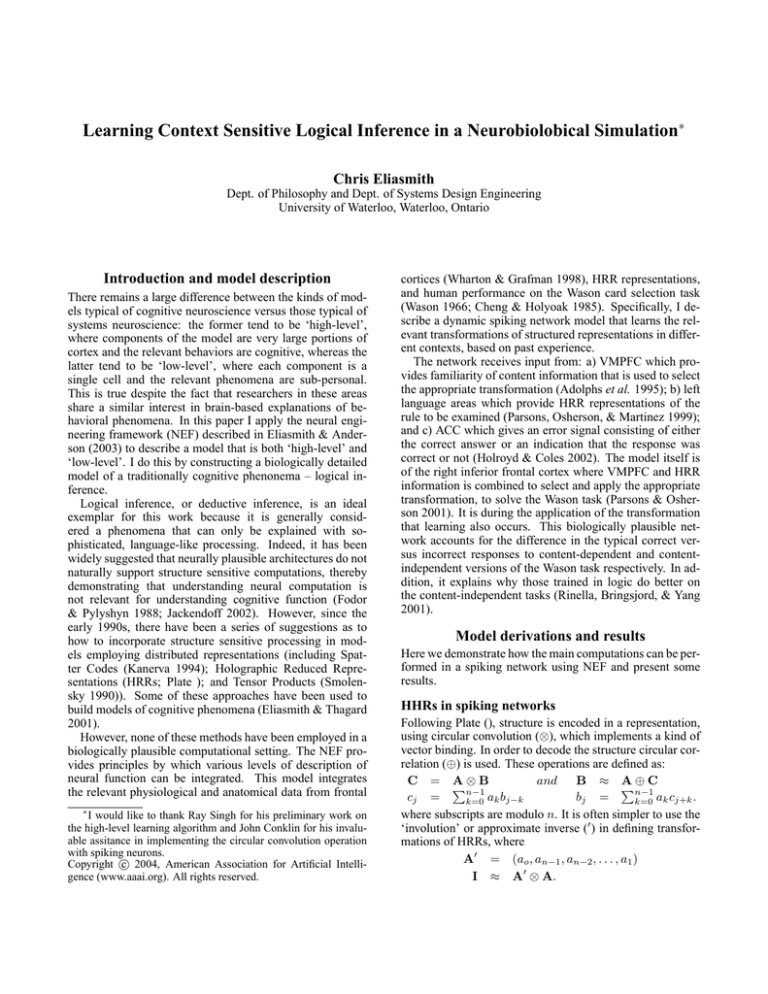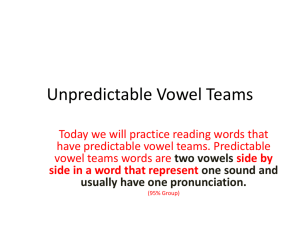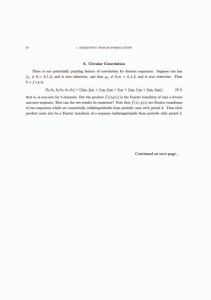
Learning Context Sensitive Logical Inference in a Neurobiolobical Simulation∗
Chris Eliasmith
Dept. of Philosophy and Dept. of Systems Design Engineering
University of Waterloo, Waterloo, Ontario
Introduction and model description
There remains a large difference between the kinds of models typical of cognitive neuroscience versus those typical of
systems neuroscience: the former tend to be ‘high-level’,
where components of the model are very large portions of
cortex and the relevant behaviors are cognitive, whereas the
latter tend to be ‘low-level’, where each component is a
single cell and the relevant phenomena are sub-personal.
This is true despite the fact that researchers in these areas
share a similar interest in brain-based explanations of behavioral phenomena. In this paper I apply the neural engineering framework (NEF) described in Eliasmith & Anderson (2003) to describe a model that is both ‘high-level’ and
‘low-level’. I do this by constructing a biologically detailed
model of a traditionally cognitive phenonema – logical inference.
Logical inference, or deductive inference, is an ideal
exemplar for this work because it is generally considered a phenomena that can only be explained with sophisticated, language-like processing. Indeed, it has been
widely suggested that neurally plausible architectures do not
naturally support structure sensitive computations, thereby
demonstrating that understanding neural computation is
not relevant for understanding cognitive function (Fodor
& Pylyshyn 1988; Jackendoff 2002). However, since the
early 1990s, there have been a series of suggestions as to
how to incorporate structure sensitive processing in models employing distributed representations (including Spatter Codes (Kanerva 1994); Holographic Reduced Representations (HRRs; Plate ); and Tensor Products (Smolensky 1990)). Some of these approaches have been used to
build models of cognitive phenomena (Eliasmith & Thagard
2001).
However, none of these methods have been employed in a
biologically plausible computational setting. The NEF provides principles by which various levels of description of
neural function can be integrated. This model integrates
the relevant physiological and anatomical data from frontal
∗
I would like to thank Ray Singh for his preliminary work on
the high-level learning algorithm and John Conklin for his invaluable assitance in implementing the circular convolution operation
with spiking neurons.
c 2004, American Association for Artificial IntelliCopyright °
gence (www.aaai.org). All rights reserved.
cortices (Wharton & Grafman 1998), HRR representations,
and human performance on the Wason card selection task
(Wason 1966; Cheng & Holyoak 1985). Specifically, I describe a dynamic spiking network model that learns the relevant transformations of structured representations in different contexts, based on past experience.
The network receives input from: a) VMPFC which provides familiarity of content information that is used to select
the appropriate transformation (Adolphs et al. 1995); b) left
language areas which provide HRR representations of the
rule to be examined (Parsons, Osherson, & Martinez 1999);
and c) ACC which gives an error signal consisting of either
the correct answer or an indication that the response was
correct or not (Holroyd & Coles 2002). The model itself is
of the right inferior frontal cortex where VMPFC and HRR
information is combined to select and apply the appropriate
transformation, to solve the Wason task (Parsons & Osherson 2001). It is during the application of the transformation
that learning also occurs. This biologically plausible network accounts for the difference in the typical correct versus incorrect responses to content-dependent and contentindependent versions of the Wason task respectively. In addition, it explains why those trained in logic do better on
the content-independent tasks (Rinella, Bringsjord, & Yang
2001).
Model derivations and results
Here we demonstrate how the main computations can be performed in a spiking network using NEF and present some
results.
HHRs in spiking networks
Following Plate (), structure is encoded in a representation,
using circular convolution (⊗), which implements a kind of
vector binding. In order to decode the structure circular correlation (⊕) is used. These operations are defined as:
C = A⊗B
and
B ≈ A⊕C
Pn−1
Pn−1
cj =
a
b
b
=
j
k=0 k j−k
k=0 ak cj+k .
where subscripts are modulo n. It is often simpler to use the
‘involution’ or approximate inverse (0 ) in defining transformations of HRRs, where
A0 = (ao , an−1 , an−2 , . . . , a1 )
I ≈ A0 ⊗ A.
m
n
Decoding
x̂ =
X
Circular Convolution for 6D Vectors
U
0.5
0
-0.5
0
0.1
0.2
0.3
0.4
0.5
0.6
0.7
0.8
0.9
1
0
0.1
0.2
0.3
0.4
0.5
0.6
0.7
0.8
0.9
1
0
0.1
0.2
0.3
0.4
0.5
0.6
0.7
0.8
0.9
1
0.5
V
As a result, the following identity holds A ⊕ B = A0 ⊗ B,
which is useful since convolution is associative and commutative but correlation is neither.
To implement convolution in a spiking network using the
NEF, we first define the encoding and decoding for a vector
x:
Encoding
h D
E
i
X
ai (t) =
δ(t − tin ) = Gi αi x · φ̃i
+ Jibias
0
-0.5
hi (t − tn )φxi
i,n
ck ([AF F T , BF F T ])
h
i
= Gk αk φ̃k ([AF F T , BF F T ]) + Jkbias
i
hP
P
bias
ω
b
+
J
ω
a
+
= Gk
jk
j
ik
i
k
j
i
where ωik = αk φ̃k1 ...kN WF F T φA
i . Then the element-wise
product is extracted and the IFFT is performed, giving
dl (A ⊗ B)
h
i
= Gl αl φ̃l (WIF F T (WF F T A.WF F T B)) + Jkbias
´
i
h ³
P
= Gl αl φ̃l WIF F T k ck φA.B
+ Jkbias
k
£P
¤
bias
= Gl
k ωlk ck + Jl
where ωlk = αl φ̃l WIF F T φA.B
. This derivation demonk
strates how spiking networks, without nonlinear dendritic
interactions can compute complex, nonlinear functions like
convolution. The implementation of convolution in a spiking network is shown to be successful in figure 1.
U⊗V
where δi (·) are the spikes at times tn for neuron ai , generated by the nonlinearity Gi (here, a LIF neuron). The αi is
a gain, φ̃i is the preferred direction vector of the neuron in
stimulus space, and Jibias is a bias current that accounts for
background activity. For the decoding, hi (t) are the linear
decoding filters which, for reasons of biological plausibility, we take to be the (unweighted) post-synaptic currents
(PSCs) in the subsequent neuron. The decoding vectors, φxi ,
are found by a least-squares method.
Assuming this kind of vector representation in four populations, a, b, c, and d we can now implement the convolution
function by using the convolution theorem. First, the two
vectors to be convolved are projected through the FFT matrix into a middle layer:
0.5
0
-0.5
Figure 1: Convolution of two 6 dimensional vectors in a
spiking network.
numbers. A transformation of the rule that provides these
results would be T1 = ante0 + impl0 ⊗ rel0 + conseq0 ,
since T1 ⊗ R ≈ vowel + even. However, in the more
familiar ‘permissive’ task, signalled in the model by differing activity from the VMPFC, subjects tend to choose the
correct answer (vowel and not even).
To model learning of these different transformations
in different contexts, we extend the work of Neumann
(2001). She noted that to find some unknown transformation T P
between two vectors
PmA and B, we can solve
m
T = circ( i Bi ⊕ Bi )−1 ( i Bi ⊕ Ai ), where circ(·)
is the circulant matrix and m is the number of examples.
However,Pnoting Bi ⊕ Bi ≈ 1 this can be simplified to
m
1
T= m
i Bi ⊕ Ai . This can be implemented using the
standard delta rule Ti+1 = Ti − wi (Ti − Ai ⊕ Bi ), where
wi is an adaptive learning rate inversely proportional to i.
This rule needs to be written in terms of individual neural
firing. The somewhat involved derivation results in the rule:
δE
∆wjl = κ δω
jl
hP
i
P
κ
0
ω
y
= α φ̃
ω
z
−
0
j j j (yj > 0)xl
j
k jk k
jk jk
As demonstrated in figure 2, this rule leads to succesful
learning, and allows for the switching of learned transformations.
Learning HRR transformations
In order to explain the results of the Wason task, we need to
transform HRRs encoding the rule being examined appropriately. For the example rule “If there is a vowel on one side of
the card, there is an even number on the other side”, we can
write: R = ante⊗vowel+rel⊗impl+cons⊗even. The
typical answer for this ‘abstract’ Wason task is for subjects
to choose to turn over the cards with vowels and with even
Results
The entire network consists of nine interconnected populations for a total of approximately twenty thousand neurons.
This network is able to reproduce the typical results from the
Wason task under both the abstract and permissive contexts,
as shown in figure 3.
References
Associative Learning for a 6D Vector (10% noise)
1.5
Learning
Context Signal
Recall
1
0.5
0
-0.5
Transformation
Signal
1
2
3
4
5
6
-1
-1.5
Figure 2: Learning of two different 6 dimensional vectors
under two different contexts.
F (Answer, smoothed, spiking convolution)
0.5
0.4
vowel, 0.753407
not_b, 0.660395
ante, 0.036040
vowel, 0.747545
not_b, 0.676916
ante, 0.03642
0.3
0.2
0.1
0
-0.1
vowel, 0.096732
not_b, 0.058189
ante, 0.018582
vowel, 0.057156
even, 0.016832
not_b, 0.009485
vowel, 0.120566
even, 0.081395
ante, 0.027278
vowel, 0.03848
even, 0.030762
ante, 0.019420
-0.2
vowel, 0.770367
even, 0.627271
not, 0.283298
-0.3
vowel, 0.788069
even, 0.638051
not, 0.288477
-0.4
0
200
400
600
800
1000
1200
1400
1600
1800
2000
Figure 3: The results from the entire network. The answers
are type written above the decoded neural output. As expected, during the first phase (after a brief learning period),
in the permissive context, the correct responses are given.
In the second phase (a ‘no task’ period) no answer is given,
and in the third phase, in the abstract context, the wrong responses are given. This pattern is repeated twice, to demonstrate that the learning is not destructive.
Adolphs, R.; Bechara, A.; Tranel, D.; Damasio, H.; and
Damasio, A. 1995. Neuropsychological approaches to reasoning and decision-making. In Damasio, A.; Damasio, H.;
and Christen, Y., eds., Neurobiology of Decision-Making.
New York: Springer Verlag.
Cheng, P. W., and Holyoak, K. J. 1985. Pragmatic reasoning schemas. Cognitive Psychology 17:391–416.
Eliasmith, C., and Anderson, C. H. 2003. Neural engineering: Computation, representation, and dynamics in neurobiological systems. Cambridge, MA: MIT Press.
Eliasmith, C., and Thagard, P. 2001. Integrating structure
and meaning: A distributed model of analogical mapping.
Cognitive Science 25:245–286.
Fodor, J., and Pylyshyn, Z. 1988. Connectionism and cognitive science: A critical analysis. Behavioral and Brain
Sciences 28:3–71.
Holroyd, C., and Coles, M. 2002. The neural basis of human error processing: Reinforcement learning, dopamine,
and the error-related negativity. Psychological Review
109:679–709.
Jackendoff, R. 2002. Foundations of Language: Brain,
Meaning, Grammar, Evolution. Oxford University Press.
Kanerva, P. 1994. The spatter code for encoding concepts
at many levels. Proceedings of International Conference
on Artificial Neural Networks 46:226–229.
Neumann, J. 2001. Holistic Processing of Hierarchical
Structures in Connectionist Networks. PhD dissertation,
University of Edinburgh, Department of Computer Science.
Parsons, L., and Osherson, D. 2001. New evidence for
distinct right and left brain systems for deductive versus
probabilistic reasoning. Cerebral Cortex 11:954–965.
Parsons, L.; Osherson, D.; and Martinez, M. 1999. Distinct neural mechanisms for propositional logic and probabilistic reasoning. Proceedings of the Psychonomic Society
Meeting 61–62.
Plate, A. Holographic reduced representations: Convolution algebra for compositional distributed representations.
In Mylopoulos, J., and Reiter, R., eds., Proceedings of the
12th International Joint Conference on Artificial Intelligence. San Mateo, CA: Morgan Kaufmann.
Rinella, K.; Bringsjord, S.; and Yang, Y. 2001. Efficacious logic instruction: People are not irremediably
poor deductive reasoners. In Moore, J., and Stenning, K.,
eds., Proceedings of the Twenty-Third Annual Conference
of the Cognitive Science Society, 851–856. Mahwah, NJ:
Lawrence Erlbaum Associates.
Smolensky, P. 1990. Tensor product variable binding and
the representation of symbolic structures in connectionist
systems. Artificial Intelligence 46:159–217.
Wason, P. C. 1966. Reasoning. In Foss, B. M., ed., New
horizons in psychology. Harmondsworth: Penguin.
Wharton, C., and Grafman, J. 1998. Deductive reasoning
and the brain. Trends in Cognitive Sciences 2:54–59.









